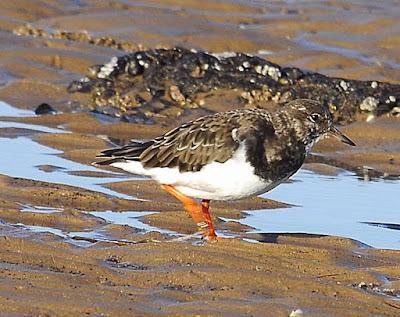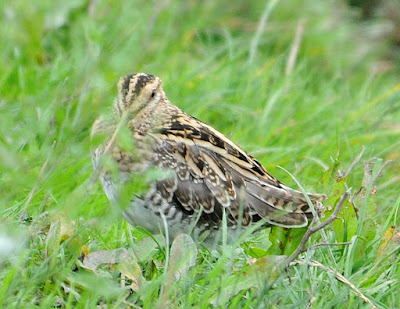Fortunately for those new to wader spotting, or those baffled by the whole group of them there are a fair few that are easy to identify, so let's have a look at these.
Another top tip for watching waders is not to be over powered by the sheer number that may be in front of you. Break them into smaller groups and just concentrate on this bunch, noting the dunlin and godwits as well as the easier ones and then there may be a few left that present more of a challenge. In reality, the vast majority of what is before you will fall into the categories above. In the UK unlikely to get 100's of sandpiper species together, just Dunlin, Lapwing, godwits and Knot. In there though may be a Little stint, a Curlew sandpiper or something even more challenging and exciting such as an American vagrant. This is where field notes are essential as mentioned in a previous part of this brief series. A reminder, make notes on plumage that stands out: tail pattern, wing bars in flight, eye stripes if present as well as leg colouration and bill shape, size and colour. Make comparisons to nearby waders that you know eg, smaller than Dunlin or longer and darker bill than an oystercatcher. When in a hide studying waders don't be afraid to point one out that is tricky to another birder. They may not have looked at this group yet and unaware of its presence. Give good details or, if in your scope, ask them to have a look. All good field skills to get the most from a session wader watching.
Titchwell Fresh Marsh from the Parrinder Hide. All very daunting to a beginner but just look at the group directly in front. Lapwings clearly visible and with them a group of mainly roosting smaller waders showing white underparts and a browny head and wing: Dunlin. Then scan through to see if anything else stands out.
Oystercatcher:
Large black and white wader showing bright orange bill and legs. Can be quite noisy with a typical piping call. Can't really be mistaken for anything else.
Avocet:
Another black and white wader but so different in shape and size to the above. Upturned bill obvious, very aggressive during breeding season to anything that gets too near nest, eggs or young. Saw an avocet actually land on a Marsh Harrier once, looked like it was surfing on it. Not the unusual blue legs.
Turnstone:
Busy bird of beach and pools. Flicks over sea weed and beach litter in search of invertebrates. Any gravel will be flicked about. Mainly seen in the UK in non breeding plumage as shown here.
In the final photo above, note size and shape compared to the Dunlin shown here. Note the straight cut off point from the dark breast to the white belly. Short, stubby and dark bill, orange legs.
Purple Sandpiper:
Not a regular bird for South East England but does show up, invariably on rocks where waves are breaking. Amazing ability to hold on to the rocks as water washes all around it. Very unlikely to find another bird behaving like this, nor actually found in such a habitat.
A very rotund wader with long toes that are orange and a slightly decurved bill that is dark at the tip and orange at the base. Has a vague purpleness to it but overall impression is a grey/brown bird. Note the visible white eye ring.
Snipe:
Whilst not overlooking similarities with Woodcock and Jack snipe, almost all snipe like birds seen will be........Snipe. Excellent camouflage and a liking for not giving up its position until a birder is just about to tread on it (similar to Woodcock) means most views of snipe are when they are out on mud or soft grassy fields probing with their ludicrously long bill. Note the head pattern of black and gold striped heading from the crown. A woodcock has them going across the crown. If the snipe is constantly bobbing up and down then it will be the slightly smaller and shorter billed Jack snipe.
Curlew:
Only similar bird is the less common, migratory whimbrel so the latter only about during April/May and late August/early October. Can be ruled out at all other times therefore making curlew easy to identify. A larger wader, long legged with huge decurved bill. Pay attention to the head pattern again especially the crown as shown here.
Not too much detail on the head pattern, just a series of streaks. The smaller whimbrel shows a clear head stripe upon the crown as shown below. Note also the much shorter decurved bill. Beware: 1st year curlews have shorter bills as they're not fully grown but the head pattern will immediately sort this confusion out. Whimbrel photo from The Camargue, the only one I have ever seen there in way over 10 trips in the last 20 years. A special place, love it there.
Common sandpiper:
Perhaps this shouldn't in the unmistakable section due to possible mix up with Green sandpiper but there is one diagnostic feature that renders this a relatively easy bird to id, even from a distance. In both these photos (Amwell and Portugal) the white patch extending upwards towards the neck is very prominent and defines Common sandpiper. Invariably lands and bobs about loads. In flight, broad white wing bars also tell it apart from the all brown wings of Green sandpiper.
Compare the plumage on this Green sandpiper to note differences. Also, in winter, Green sandpiper almost 100% by fresh water and Common sandpiper, being a summer visitor will have returned south so can be ruled out after October and before April.
The lack of the white "shoulder" here is very clear showing this indeed to be a Green sandpiper.
Little Stint:
Again, Little stints shouldn't really be in this section as their plumage is similar to many other waders, especially Curlew sandpiper and Dunlin but just their diminutive size gives them away when seen feeding with other species, such as dunlin. See photo below showing a Black tailed godwit, 2 Golden plover, a feeding Dunlin and then the tiny Little stint. Same size as a Great tit!!
Here another view of the same bird. This taken at the fantastic Oare Marshes, near Faversham. A great wader watching place where you can watch from the comfort of your own car! From back to front: Black tailed godwit, Golden plover, Dunlin and Little stint. Note straight bill compared to the usual decurved bill of the Dunlin.
First year Little stints can be identified by what are known as tramlines. These are 2 distinct white lines running down the back of the bird as illustrated here. These from Titchwell, North Norfolk.
No tramlines here so adult bird. Note the 4th photo shows a Little stint either moulting from or into breeding plumage. Compare with first two snaps where full non breeding plumage is shown.
Just one final comment. If you see a Little stint with yellow/light coloured legs you have a rare Temminck's stint! Only ever seen 3 in the UK in over 50 years of birding so don't worry about it too much!
Underwing of Little stint but such a fast flyer very rare to get a good glimpse.
To conclude this brief intro to waders I include a favourite photo from many years ago on Titchwell beach. Just love the amount of species and the photo does not include all the other waders on the beach along with gulls and sea duck out to sea. Fantastic place.
Here Curlew heading left, redshank, 5 Oystercatchers, Grey plover in breeding plumage, Black headed gull in non breeding plumage, and 3 Black tailed godwit.
Hope this mini-guide has been of use and give folk a little knowledge to help with a tricky group of birds.




























No comments:
Post a Comment